Abstract
Symmetric organic compounds are generally obtained inexpensively, and therefore they can be attractive building blocks for the total synthesis of various pharmaceuticals and natural products. The drawback is that discriminating the identical functional groups in the symmetric compounds is difficult. Water is the most environmentally benign and inexpensive solvent. However, successful organic reactions in water are rather limited due to the hydrophobicity of organic compounds in general. Therefore, desymmetrization reactions in aqueous media are expected to offer versatile strategies for the synthesis of a variety of significant organic compounds. This review focuses on the recent progress of desymmetrization reactions of symmetric organic compounds in aqueous media without utilizing enzymes.
1. Introduction
Desymmetrization reactions starting from symmetric compounds are among the most cost-effective conversions in synthetic organic chemistry that are advantageous for the total synthesis of complex natural products or pharmaceuticals, because the starting materials, symmetric compounds, are typically prepared at a large scale from inexpensive sources, or are commercially available at low cost. Among the numerous solvents, water is one of the most environmentally friendly and inexpensive solvents, and thus water-mediated organic reactions are typically regarded as a “green chemistry.” Combining these concepts, the water-mediated desymmetrization of symmetric organic compounds is expected to offer remarkable synthetic values.
Discriminating the identical functional groups existing in symmetric compounds is considered arduous. Organic compounds generally do not dissolve in water in significant amounts because of their hydrophobic properties. As a result, the studies of water-mediated desymmetrization reactions of symmetric organic compounds have been rather limited.
Enzyme reactions are a relatively common approach to accomplishing desymmetrization in aqueous media. Well-known examples for enzymatic desymmetrization reactions include the monohydrolysis of symmetric diesters and the mono-esterification of symmetric diols. Conditions for enzyme reactions are typically mild and environmentally benign, and therefore such approaches are considered green chemistry. A number of studies of the total synthesis of various significant natural products or pharmaceuticals by the application of enzymatic desymmetrization have also been reported [1,2,3,4,5,6,7,8,9]. The somewhat unfortunate part is that the random screening of various enzymes and substrate symmetric compounds is still often required for enzymatic desymmetrization despite the recent progress in the area of modeling approaches for mono-esters based on X-ray crystallography.
A fairly good number of reviews of enzymatic desymmetrization reactions have already been published [1,2,3,4,5,6,7,8,9], and reviews of non-enzymatic desymmetrization reactions in organic solvents have also been published [10,11,12,13]. Therefore, this review highlights some of the recent progress in the research of non-enzymatic desymmetrization reactions in aqueous reaction media. Such studies have also been explored only recently since around 2000, and it is still worthwhile for many researchers to pursue further investigation.
2. Water-Mediated Non-Enzymatic Desymmetrization
Among the most well-known non-enzymatic desymmetrization reactions are the ring opening reactions of strained cyclic compounds such as epoxides. The driving force of these reactions is the relief of the bond angle strain. Asymmetric versions have also been actively investigated in this area. Among the most remarkable work in the asymmetric ring opening reactions of meso epoxides in water was reported by Kobayashi et al. [14,15] (Scheme 1). They were successful in the asymmetric ring opening with high chemical and optical yields using various metals such as Zn(II), Cu(II), Sc(III) surfactant-type catalysts in water through the mechanism exemplified below. They also found that the reactions proceeds faster than in dichloromethane. It was found that the hydrophobic interactions among the reactants and Lewis acid surfactant combined catalysts in aqueous media accelerated the reaction rates.
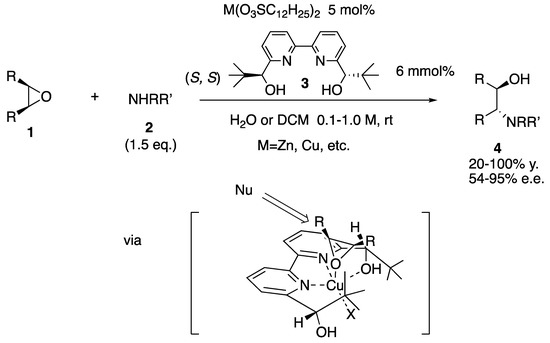
Scheme 1.
Examples of the asymmetric ring opening of symmetric epoxide reported by Kobayashi et al.
Inspired by Kobayashi’s work, Fringuelli and Pizzo et al. also explored aminolysis of various meso epoxides in water with the use of Zn(II) [16] (Scheme 2).
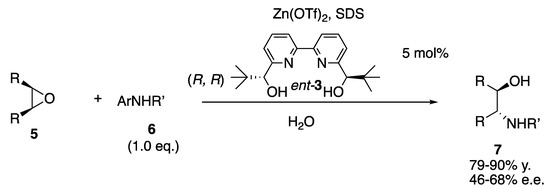
Scheme 2.
Examples of epoxide opening by Fringuelli and Pizzo et al. (SDS: sodium dodecyl sulfate).
Related to this ring-opening of epoxides, Jacobsen et al. reported the hydrolytic desymmetrization of meso epoxides catalyzed by an oligomeric (salen) Co catalyst with 1.2 equivalents of water, although the solvent was CH3CN [17]. Kureshy et al. reported that ring opening desymmetrization reactions of stilbene oxide with the chiral ligands they synthesized can effectively be performed with water as an additive [18].
Other non-enzymatic desymmetrization reactions in aqueous media include the selective monobenzylation of 1,2- and 1,3-diols reported by Muramatsu et al. employing Me2SnCl2, N,N-dimethylaminopyridine (DMAP), potassium carbonate, 4-(4,6-dimethoxy-1,3,5-triazin-2-yl)-4-methylmorpholinium chloride (DMT-MM) [19] (Scheme 3). Under organic solvent-free conditions at room temperature, monobenzoates were obtained up to 97% for cis-cyclooctane-1,2-diol as well as other 1,2 and 1,3-diols. The key intermediate for the mechanism of the first reaction was proposed to involve a cyclic stannylene complex which reacts with benzoly chloride, the condensation product of BzOH and DMT-MM, or an acyl pyridinium intermediate generated with the aid of DMAP.
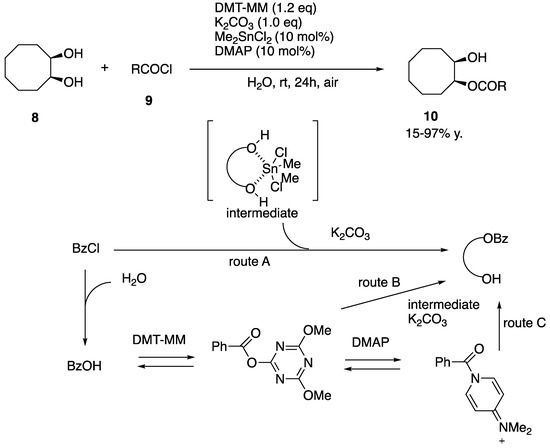
Scheme 3.
Examples of selective monobenzylation by Muramatsu et al.
More recently, Asano and Matsubara reported that the water-assisted desymmetrization of gem-diols with an organocatalyst leads to enantio- and diastereoselective tetrahydropyran (THP) ring formation [20]. The use of water as a solvent can lead to the good yields of the products, although DCM was employed as the primary solvent and three equivalents of water was added as a reactant due to the better enantioselectivities.
Perhaps among the most pioneering non-enzymatic water-mediated desymmetrization reactions are the selective monohydrolysis reactions of symmetric diesters reported by Niwayama et al. [21,22,23,24,25,26,27,28,29,30,31]. This reaction distinguishes between the two identical ester groups in water with or without a co-solvent, affording half-esters from a series of symmetric diesters with high yields (up to >99%), a selectivity which was formerly impossible in organic media by selective monosaponification reactions in alcohol solvents, for example (Scheme 4a).
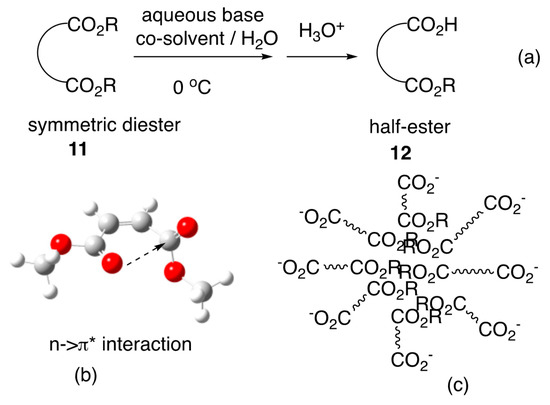
Scheme 4.
(a) Selective monohydrolysis of symmetric diesters reported by Niwayama et al. (b) n- > π* interaction found in symmetric diesters (c) potential micelle-like aggregates by the reaction intermediate
The reaction mechanism that has been proposed is that potential conformational bias due to the attractive interactions between the two closely located carboalkoxy groups in these diesters contributes to distinguishing between the two identical ester groups for this selectivity, smoothing the way for the hydrolysis of a carboalkoxy group from one particular direction. The existence of the n- >π * interaction is inferred by theoretical studies for such an interaction [22] (Scheme 4b). An additional proposed mechanistic hypothesis includes the formation of micelle-like aggregates wherein the hydrophobic carboalkoxy groups are directed inside and the hydrophilic COO− groups are directed outside in the aqueous media, prohibiting further hydrolysis by the aqueous NaOH solution after the monohydrolysis occurs [23] (Scheme 4c). Based on these mechanistic hypotheses, reaction conditions can be tuned, and higher selectivities have been achieved for many cases in which the selective monohydrolysis is difficult [26,27,28,29,30].
Starting from the half-esters having the norbornadiene skeleton obtained by this selective monohydrolysis reaction, libraries of polymers have also been synthesized in combination with the ring opening metathesis polymerization (ROMP) recently [32]. The polymers thus prepared have highly controlled structures, allowing the production of various amphiphilic polymers as well.
A similar mechanism has been proposed for the desymmetrization reaction reported by Chong et al. as well. They studied the selective monobromination of symmetric diols in the aqueous HBr/toluene two-phase media with high selectivities, affording high (>90%) yields of monobromides, even though statistically the expected yields are a maximum of 50% as in the above monohydrolysis [33] (Scheme 5). As the mechanism for the selectivity, they propose the reversed micelle-like structure by the bromo alcohol in which the polar hydroxy groups are pointed inside, which is expected to serve as a barrier from the exposure from the aqueous HBr.
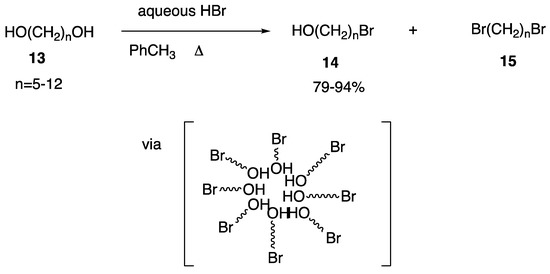
Scheme 5.
Selective monohydrolysis of symmetric diesters reported by Chong et al.
Another area attracting interest is the desymmetrization of symmetric carbonyl compounds by aldol reactions. In particular, some impressive studies have been reported in the area of asymmetric aldol reactions of prochiral ketones with the use of proline-based catalysts or other chiral diamine catalysts in water. It is generally explained that the ability to form double hydrogen bonding by these catalysts and the transition state involving an enamine formed by the catalyst sequestered from aqueous media by hydrophobic effects are responsible for the reactivity. Among the most pioneering works for such aldol reactions was reported by Barbas et al. [34] (Scheme 6). They reported that cyclohexanone with various arylaldehydes undergoes asymmetric aldol reactions in the presence of a catalytic amount of a variety of proline derivatives or pyrrolidine-based diamines in water.
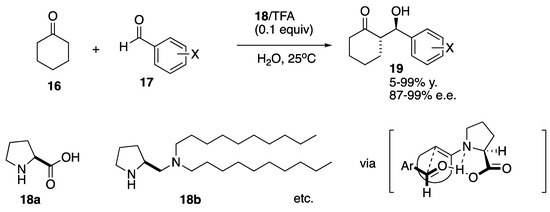
Scheme 6.
Examples of asymmetric aldol reactions of cyclohexanone reported by Barbas et al. (TFA: trifluoroacetic acid).
Hayashi et al. also reported asymmetric aldol reactions of cyclohexanone with various aryl aldehydes catalyzed by protected 4-hydroxyproline derivatives in water leading to improved diastero- and enantioselectivities [35] (Scheme 7).
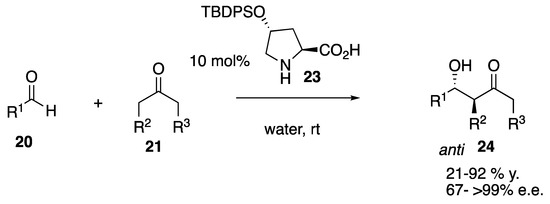
Scheme 7.
Examples of asymmetric aldol reactions of symmetric ketones reported by Hayashi et al.
Singh et al. studied asymmetric aldol reactions with acetone and other symmetric ketones with various aryl aldehydes catalyzed by other proline derivatives in water or brine [36] (Scheme 8). The hydrophobic effects by the use of water were emphasized due to the salting-out effect by the use of brine.
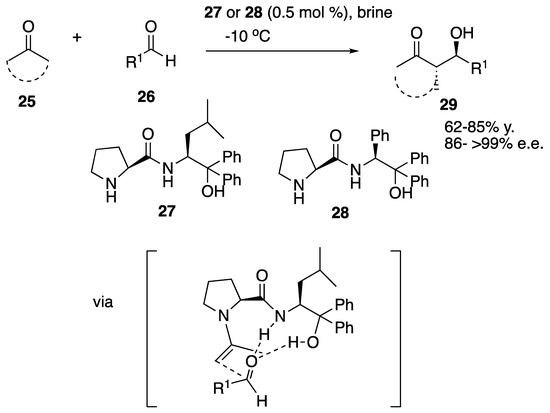
Scheme 8.
Examples of asymmetric aldol reactions of symmetric ketones reported by Singh et al.
Luo and Cheng et al. reported highly stereoselective aldol reactions of symmetric ketones and aromatic aldehydes in the presence of proline-based or pyrrolidine-based chiral amines and surfactant Brønsted acids [37] (Scheme 9). They also demonstrated that similar conditions are applicable to Michael reactions with nitrostyrene derivatives in water. They propose that the reactions occur in micelles generated by these reactants and additives.

Scheme 9.
Examples of asymmetric aldol reactions and Michael additions of symmetric ketones reported by Luo and Cheng et al. (DBSA: p-dodecylbenzenesulfonic acid).
Fu et al. prepared the L-prolineamide phenols and utilized them for the direct aldol reactions of cyclohexanone with aryl aldehydes in water [38] (Scheme 10). The high diastereo- and enantioselectivities in water was explained by the hydrophobicity of the organic reactants and the hydrogen bonding among water and polar atoms in the reactants at the transition state, both of which bring these reactants closer together.
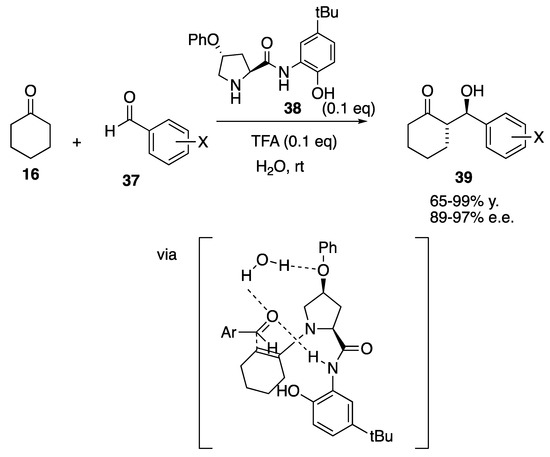
Scheme 10.
Examples of the asymmetric aldol reactions of cyclohexanone reported by Fu et al.
Later, Kototos et al. explored the enantioselective aldol reactions of cyclohexanones with arylaldehydes in the presence of various peptides in addition to proline derivatives in water, various organic solvents, or in a mixture of acetonitrile and water (10:1) (Scheme 11). They found that the wet acetonitrile in the presence of 4-nitrobenzoic acid (4-NBA) as an additive afforded the best results [39].
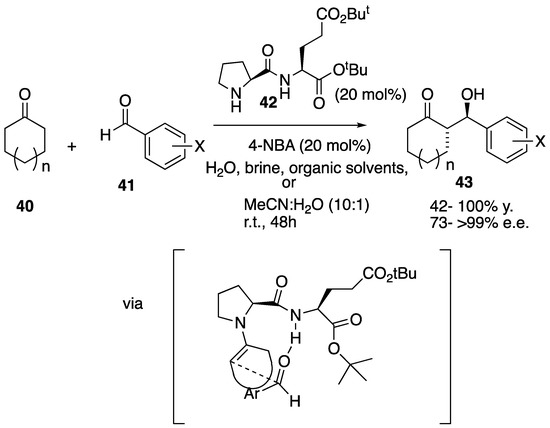
Scheme 11.
Examples of asymmetric aldol reactions of symmetric cyclic ketones reported by Kototos et al.
Fioravanti et al. studied the desymmetrization of N, N’-dialkyl α-diimines reacted with NsONHCO2Et and calcium oxide in a solvent composed of a mixture of dichloromethane and water (1:4), which produced monodiaridine with high diastereoselectivity [40] (Scheme 12). They also found that the intermediate is likely to be stabilized by water, leading to the high selectivity.

Scheme 12.
Examples of the desymmetrization of diimines reported by Fioravanti et al.
Conejero, Michelet, and Cadierno et al. reported the selective cycloisomerization of symmetric bispropargylic carboxylic acids catalyzed by a water-soluble Au(III) catalyst (47) in a toluene/water (1/1) biphasic media [41] (Scheme 13). The selectivities are particularly high with terminal alkynes. It is also advantageous that the biphasic catalyst can be recycled for reuse.
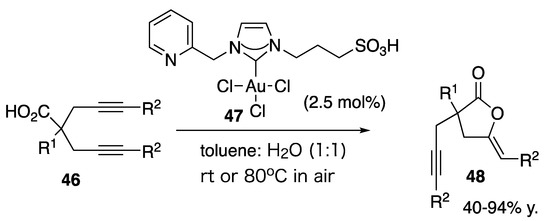
Scheme 13.
Examples of the selective cycloisomerization of symmetric bispropargylic carboxylic acids reported by Conejero, Michelet, and Cadierno et al.
Benniston et al. reported the interesting desymmetrization of 1,1′-ferrocenedicarboxaldehyde in aqueous media. Oxidation of 1,1′-ferrocenedicarboxaldehyde with KMnO4 in a water/acetonitrile mixture yielded 1′-formyl ferrocenecarboxylic acid, while in a water/acetone mixture yielded 1′-[(E)-3-oxo-but-1-enyl]-ferrocenecarboxylic acid [42] (Scheme 14).

Scheme 14.
Desymmetrization of 1,1′-ferrocenedicarboxaldehyde reported by Benniston et al.
The remaining examples listed below are desymmetrization reactions in which water is utilized as a co-solvent or an additive. For example, Nakada et al. reported the catalytic asymmetric intramolecular cyclopropanation of an α-diazo ketone in the presence of 10 equivalents of water refluxing in toluene [43] (Scheme 15).
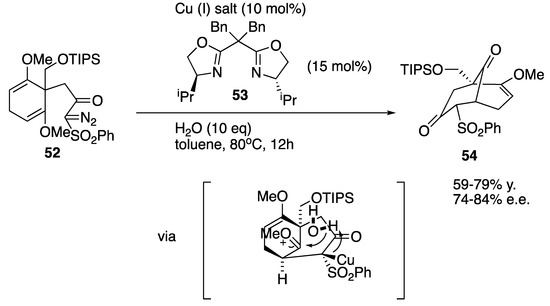
Scheme 15.
Examples of catalytic asymmetric intramolecular cyclopropanation of an α-diazo ketone reported by Nakada et al.
Yu et al. studied the desymmetrization of glutaric anhydrides for the production of chiral fluorides via the sequential alkoholysis in the presence of an organocatalyst followed by photoredox-catalyzed fluorination. The latter process applied a solvent consisting of a mixture of acetonitrile and water (1:1) [44] (Scheme 16).
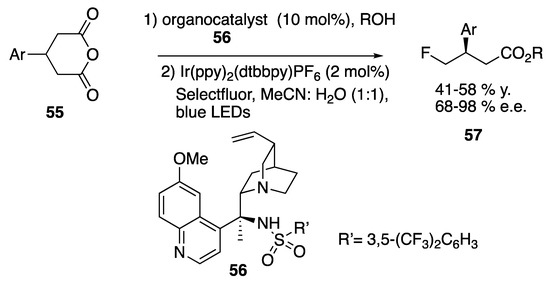
Scheme 16.
Examples of desymmetrization of glutaric anhydride reported by Yu et al.
Álvarez, Ribagorda, and Carreño explored the Friedel–Crafts alkylation reactions of indols with symmetric p-quinols in the presence of FeCl3·H2O or chiral catalysts and found that water molecules play important roles by forming a compact cavity in the transition state leading to higher selectivity and by stabilizing the transition state [45] (Scheme 17).
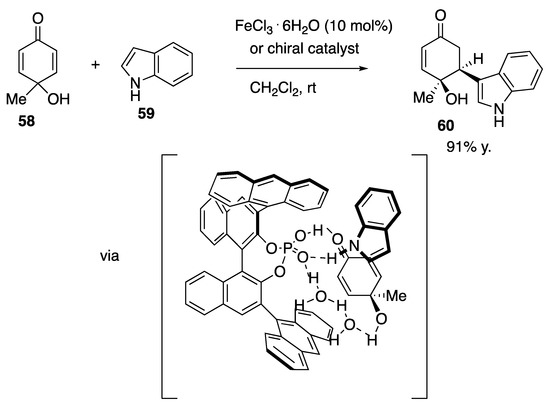
Scheme 17.
Examples of the Friedel–Crafts alkylation of indol with p-quinols reported by Álvarez, Ribagorda, and Carreño et al.
Sun et al. studied the enantioselective ring opening of symmetric oxetanes with suitable chlorides in the presence of a chiral catalyst. They reported that the unprecedented use of wet molecular sieves plays a key role for the controlled release of HCl [46] (Scheme 18).
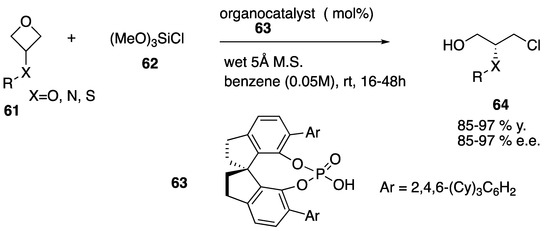
Scheme 18.
Examples of oxetane ring opening reported by Álvarez, Ribagorda, and Carreño et al.
Overall, the best results from these reactions can be summarized in the Table 1.

Table 1.
Summary of non-enzymatic desymmetrization reactions in aqueous media.
As in Table 1, yields of these non-enzymatic desymmetrization reactions with the use of water as a main solvent or a co-solvent vary, which leaves values for further development. In general, it appears that the yields are higher when some mechanistic insight is available. Our laboratory was among the first to report the non-enzymatic desymmetrization reactions in aqueous media starting from symmetric diesters [21]. Since we have the mechanistic hypotheses, we were able to use them to optimize the reaction conditions for the selective monohydrolysis of many symmetric diesters for the best yields without relying on special devices. Since the initial publication, these selective monohydrolysis reactions have been applied to the synthesis of a variety of notable compounds such as pharmaceuticals, natural products, and polymers. As more mechanistic insights become available for other desymmetrization reactions as well, this research area is likely to generate powerful tools for the construction of many significant compounds as in enzymatic desymmetrization reactions, approaches which nowadays are shifting to more mechanism-driven utilizing modeling studies from random-screening.
The research about water-mediated organic reactions is still a new area. In particular, studies on non-enzymatic desymmetrization reactions in aqueous media are quite new, and have attracted researchers’ attention only recently, since around 2000. It is anticipated that many results from this research area will offer uniqueness or novelty, potentially building up significant outcomes useful for modern synthetic organic chemistry. Considering their cost–effectiveness and environmentally benign nature, these desymmetrization results are expected to develop into additional cost–effective “green” reactions applicable to the synthesis of many more significant organic compounds.
Funding
The author thanks financial support from JST J-RAPID Grant Number JPMJJR2003, Japan.
Institutional Review Board Statement
Not applicable.
Informed Consent Statement
Not applicable.
Data Availability Statement
Not applicable.
Conflicts of Interest
The author declares no conflict of interest.
Abbreviations
| SDS | sodium dodecyl sulfate |
| DMAP | N,N-dimethylaminopyridine |
| DMT-MM | 4-(4,6-dimethoxy-1,3,5-triazin-2-yl)-4-methylmorpholinium chloride |
| THP | tetrahydropyran |
| ROMP | ring opening metathesis polymerization |
| TFA | trifluoroacetic acid |
| DBSA | p-dodecylbenzenesulfonic acid |
| 4-NBA | 4-nitrobenzoic acid |
| Ns | nosyl |
| ppy | (2-pyridinyl) phenyl |
| dtbbpy | 4,4′-Di-tert-butyl-2,2′-bipyridine |
| LED | light-emitting diode |
References
- Ohno, M.; Otsuka, M. Chiral synthons by ester hydrolysis catalyzed by pig liver esterase. Org. React. 1989, 37, 1–55. [Google Scholar] [CrossRef]
- Schoffers, E.; Golebiowski, A.; Johnson, C.R. Enantioselective synthesis through enzymatic asymmetrization. Tetrahedron 1996, 56, 3769–3826. [Google Scholar] [CrossRef]
- Schmid, R.D.; Verger, R. Lipases: Interfacial enzymes with attractive applications. Angew. Chem. Int. Ed. 1998, 37, 1608–1633. [Google Scholar] [CrossRef]
- García-Urdiales, E.; Alfonso, I.; Gotor, V. Enantioselective enzymatic desymmetrizations in organic synthesis. Chem. Rev. 2011, 111, PR110–PR180. [Google Scholar] [CrossRef] [PubMed]
- Niwayama, S. Recent desymmetrization reactions by CALB. SSRG Int. J. Appl. Chem. 2020, 7, 37–39. [Google Scholar] [CrossRef]
- Patti, A.; Sanifilippo, C. Breaking molecular symmetry through biocatalytic reactions to gain access to valuable chiral synthons. Symmetry 2020, 12, 1454. [Google Scholar] [CrossRef]
- Akai, S. Development of novel asymmetric reactions oriented to next-generation enzymatic organic syntheses. Yakugaku Zasshi 2003, 123, 919–931. [Google Scholar] [CrossRef][Green Version]
- Hudlicky, T.; Reed, J.W. Application of biotransformations and biocatalysis to complexity generation in organic synthesis. Chem. Soc. Rev. 2009, 38, 3117–3132. [Google Scholar] [CrossRef] [PubMed]
- Akai, S.; Kita, Y. Recent progress on the lipase-catalyzed asymmetric syntheses. J. Synth. Org. Chem. Jpn. 2007, 65, 772–782. [Google Scholar] [CrossRef]
- Borissov, A.; Davies, T.Q.; Ellis, S.R.; Fleming, T.A.; Richardson, M.S.W.; Dixon, D.J. Organocatalytic enantioselective desymmetrisation. Chem. Soc. Rev. 2016, 45, 5474–5540. [Google Scholar] [CrossRef] [PubMed]
- Enríquez-García, Á.; Kündig, E.P. Desymmetrisation of meso-diols mediated by non-enzymatic acyl transfer catalysis. Chem. Soc. Rev. 2012, 41, 7803–7831. [Google Scholar] [CrossRef]
- Peterson, K.S. Nonenzymatic enatioselective synthesis of all-carbon quaternary centers through desymmetrization. Tetrahedron Lett. 2015, 56, 6523–6535. [Google Scholar] [CrossRef]
- Quintavalla, A.; Cerisoli, L.; Montroni, E. Enantioselective desymmetrization promoted by bifunctional organocatalysts. Curr. Organocatalysis 2014, 1, 107–171. [Google Scholar] [CrossRef]
- Kokubo, M.; Naito, T.; Kobayashi, S. Chiral zinc (II) and copper (II)-catalyzed asymmetric ring-opening reactions of meso-epoxides with aniline and indole derivatives. Tetrahedron 2010, 66, 1111–1118. [Google Scholar] [CrossRef]
- Ogawa, C.; Kokubo, M.; Kobayashi, S. Asymmetric ring-opening reactions of meso-epoxides using metal-chiral bipyridine complexes. J. Synth. Org. Chem. Jpn. 2010, 68, 718–728. [Google Scholar] [CrossRef]
- Bonollo, S.; Fringuelli, F.; Pizzo, F.; Vaccaro, L. Zn (II)-catalyzed desymmetrization of meso-epoxides by aromatic amines in water. Synlett 2008, 10, 1574–1578. [Google Scholar] [CrossRef]
- White, D.E.; Tadross, P.M.; Lu, Z.; Jacobsen, E.N. A broadly applicable and practical oligomeric (salen)co catalyst for enantioselective epoxide ring-opening reactions. Tetrahedron 2014, 70, 4165–4180. [Google Scholar] [CrossRef]
- Kumar, M.; Kureshy, R.I.; Ghosh, D.; Khan, N.H.; Abdi, S.H.R.; Bajaj, H.C. Synthesis of chiral ligands with multiple stereogenic centers and their application in titanium (IV)-catalyzed enantioselective desymmetrization of meso-epoxides. ChemCatChem 2013, 5, 2336–2342. [Google Scholar] [CrossRef]
- Muramatsu, W.; William, J.M.; Onomura, O. Selective monobenzoylation of 1,2- and 1,3-diols catalyzed by Me2SnCl2 in water (organic solvent free) under mild conditions. J. Org. Chem. 2012, 77, 754–759. [Google Scholar] [CrossRef] [PubMed]
- Murata, R.; Matsumoto, A.; Asano, K.; Matsubara, S. Desymmetrization of gem-diols via water-assisted organocatalytic enantio- and diastereoselective cycloetherification. Chem. Commun. 2020, 56, 12335–12338. [Google Scholar] [CrossRef]
- Niwayama, S. Highly efficient selective monohydrolysis of symmetric diesters. J. Org. Chem. 2000, 65, 5834–5836. [Google Scholar] [CrossRef]
- Cho, H.; Alexander, R.B.; Niwayama, S. Conformational analysis of symmetric diesters. Curr. Org. Chem. 2012, 16, 1151–1158. [Google Scholar] [CrossRef]
- Niwayama, S. Highly efficient and practical selective monohydrolysis of symmetric diesters: Recent progress and scope. J. Synth. Org. Chem. Jpn. 2008, 66, 983–994. [Google Scholar] [CrossRef]
- Niwayama, S.; Wang, H.; Hiraga, Y.; Clayton, J.C. Studies of solvent effects in the highly efficient selective monohydolysis of symmetric diesters. Tetrahedron Lett. 2007, 48, 8508–8510. [Google Scholar] [CrossRef]
- Niwayama, S.; Rimkus, A. Effects of counter cations in selective monohydrolyses of symmetric diesters. Bull. Chem. Soc. Jpn. 2005, 78, 498–500. [Google Scholar] [CrossRef]
- Niwayama, S.; Cho, H.; Lin, C. Highly efficient selective monohydrolysis of dialkyl malonates and their derivatives. Tetrahedron Lett. 2008, 49, 4434–4436. [Google Scholar] [CrossRef]
- Niwayama, S.; Cho, H. Practical large scale synthesis of half-esters of malonic acid. Chem. Pharm. Bull. 2009, 57, 508–510. [Google Scholar] [CrossRef] [PubMed]
- Niwayama, S.; Cho, H.; Zabet-Moghaddam, M.; Whittlesey, B.R. Remote exo/endo selectivity in selective monohydrolysis of dialkyl bicyclo[2.2.1]heptane-2,3-dicarboxylate derivatives. J. Org. Chem. 2010, 75, 3775–3780. [Google Scholar] [CrossRef]
- Shi, J.; Zhao, T.; Niwayama, S. Practical selective monohydrolysis of bulky symmetric diesters: Comparing with sonochemistry. Tetrahedron 2018, 74, 6815–6820. [Google Scholar] [CrossRef]
- Shi, J.; Niwayama, S. Practical selective monohydrolysis of bulky symmetric diesters. Tetrahedron Lett. 2018, 59, 799–802. [Google Scholar] [CrossRef]
- Niwayama, S.; Hiraga, Y. New exo/endo selectivity observed in monohydrolysis of dialkyl bicyclo[2.2.1]hept-5-ene-2,3-dicarboxylates. Tetrahedron Lett. 2003, 44, 8567–8570. [Google Scholar] [CrossRef]
- Shi, J.; Hayashishita, Y.; Takata, T.; Nishihara, Y.; Niwayama, S. Syntheses of polynorbornadienes by ring-opening metathesis polymerizations (ROMP) of symmetric and non-symmetric 2,3-bis(alkoxycarbonyl)norbornadienes and their conversion to half-ester derivatives. Org. Biomol. Chem. 2020, 18, 6585–6746. [Google Scholar] [CrossRef] [PubMed]
- Chong, J.M.; Heuft, M.A.; Rabbat, P. Solvent effects on the monobromination of α, ω-diols: A convenient preparation of ω-bromoalkanols. J. Org. Chem. 2000, 65, 5837–5838. [Google Scholar] [CrossRef] [PubMed]
- Mase, N.; Nakai, Y.; Ohara, N.; Yoda, H.; Takabe, K.; Tanaka, F.; Barbas, C.F., III. Organocatalytic direct asymmetric aldol reactions in water. J. Am. Chem. Soc. 2006, 128, 734–735. [Google Scholar] [CrossRef] [PubMed]
- Hayashi, Y.; Sumiya, T.; Takahashi, J.; Gotoh, H.; Urushima, T.; Shoji, M. Highly diastereo- and enantioselective direct aldol reactions in water. Angew. Chem. Int. Ed. 2006, 45, 958–961. [Google Scholar] [CrossRef] [PubMed]
- Maya, V.; Raj, M.; Singh, V.K. Highly enantioselective organocatalytic direct aldol reaction in an aqueous medium. Org. Lett. 2007, 9, 2593–2595. [Google Scholar] [CrossRef]
- Luo, S.; Xu, H.; Li, J.; Zhang, L.; Mi, X.; Zheng, X.; Cheng, J.-P. Facile evolution of asymmetric organocatalysis in water assisted by surfactant Brønsted acids. Tetrahedron 2007, 63, 11307–11314. [Google Scholar] [CrossRef]
- Zhang, S.; Fu, X.; Fu, S. Rationally designed 4-phenoxy substituted prolineamide phenols organocatalyst for the direct aldol reaction in water. Tetrahedron Lett. 2009, 50, 1173–1176. [Google Scholar] [CrossRef]
- Bisticha, A.; Triandafillidi, I.; Kototos, C.G. tert-Butyl esters of peptides as organocatalysts for the asymmetric aldol reaction. Tetrahedron Asymmetry 2015, 26, 102–108. [Google Scholar] [CrossRef]
- Aresu, E.; Fioravanti, S.; Pellacani, L.; Sciubba, F.; Trulli, L. Water-controlled chiral inversion of a nitrogen atom during the synthesis of diazirines from α-branched N, N’-dialkyl α-diimines. New J. Chem. 2013, 37, 4125–4129. [Google Scholar] [CrossRef]
- Tomás-Mendivil, E.; Toullec, P.Y.; Díez, J.; Conejero, S.; Michelet, V.; Cadierno, V. Cycloisomerization versus hydration reactions in aqueous media: A Au (III)-NHC catalyst that makes the difference. Org. Lett. 2012, 14, 2520–2523. [Google Scholar] [CrossRef]
- Benniston, A.C.; Sirbu, D.; Turta, C.; Probert, M.R.; Clegg, W. A simple method for desymmetrizing 1,1′-ferrocenedicarboxaldehyde. Tetrahedron Lett. 2014, 55, 3777–3780. [Google Scholar] [CrossRef][Green Version]
- Uetake, U.; Uwamori, M.; Nakada, M. Enantioselective approach to polycyclic polyprenylated acylphloroglucinols via catalytic asymmetric intramolecular cyclopropanation. J. Org. Chem. 2015, 80, 1735–1745. [Google Scholar] [CrossRef] [PubMed]
- Zhao, J.-J.; Yu, S. Synthesis of chiral fluorides by sequential organocatalyzed desymmetrization of glutaric anhydrides and photoredox-catalyzed dicarboxylic fluorination. Synlett 2021, 32, 391–394. [Google Scholar] [CrossRef]
- García-García, C.; Ortiz-Rojano, L.; Álavarez, S.; Álavarez, R.; Ribagorda, M.; Carreño, M.G. Friedel–Crafts alkylation of indoles with p-quinols: The role of hydrogen bonding of water for the desymmetrization of the cyclohexadienone system. Org. Lett. 2016, 18, 2224–2227. [Google Scholar] [CrossRef] [PubMed]
- Yang, W.; Wang, Z.; Sun, J. Enantioselective oxetane ring opening with chloride: Unusual use of wet molecular sieves for the controlled release of HCl. Angew. Chem. Int. Ed. 2016, 55, 6954–6958. [Google Scholar] [CrossRef] [PubMed]
Publisher’s Note: MDPI stays neutral with regard to jurisdictional claims in published maps and institutional affiliations. |
© 2021 by the author. Licensee MDPI, Basel, Switzerland. This article is an open access article distributed under the terms and conditions of the Creative Commons Attribution (CC BY) license (https://creativecommons.org/licenses/by/4.0/).